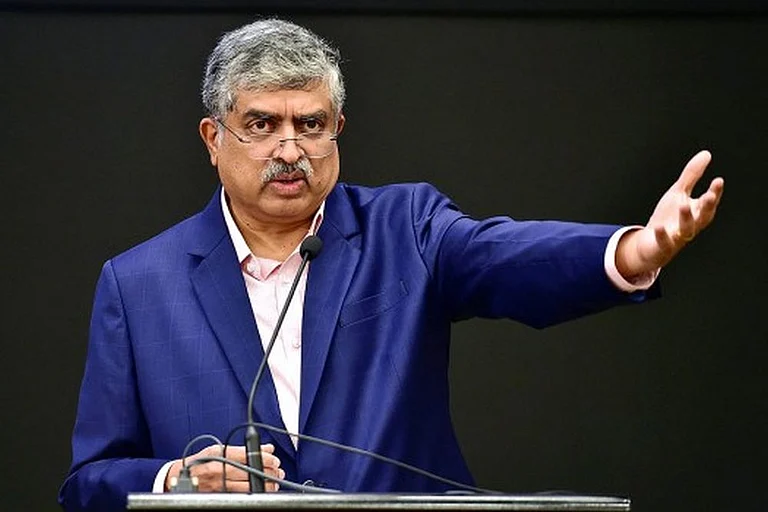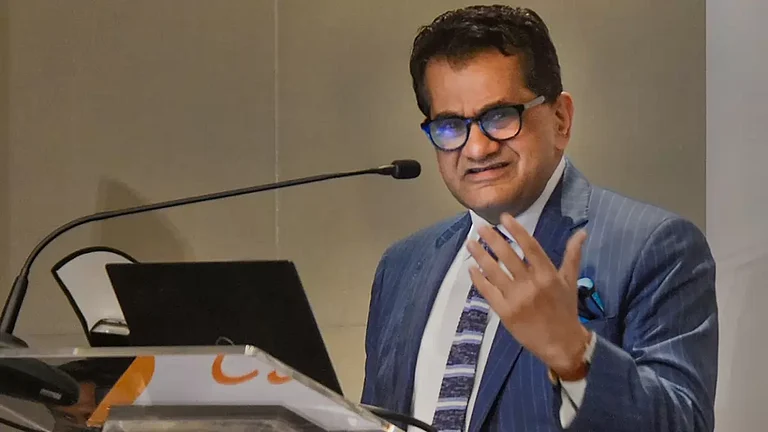India must shift from imitation to innovation to lead globally in areas like payments, AI, and crypto.
Digital Public Infrastructure (DPI) successes such as UPI, Aadhaar, MOSIP, and DEPA provide a strong foundation for India’s global leadership.
To sustain momentum, India must pioneer next-gen technologies instead of relying on replication of existing global models.
India Has Missed The Bus to Scale UPI Globally: iSPIRT's Sharad Sharma
India has made significant strides in digital public infrastructure but to lead globally in payments, AI and crypto, it must move beyond replication and pioneer the next generation of innovation
While India continues to position itself as a product-oriented nation, it must also pioneer paths yet unexplored by the rest of the world to truly lead the way forward, says Sharad Sharma, founder of the technology think tank iSPIRT and one of the earliest advocates for India’s transformation into a product nation.
In a recent conversation with Outlook Business, Sharma reflected on how far India has come in its digital journey and shared his insights on what the country needs today to strengthen its India Stack (UPI, Aadhar, Digilocker) and take it global.
Excerpt:
As one of the earliest advocates of India as a product nation, how far has the country come and what remains to be done?
The journey of building a product nation for many of us began in 2009. The first innings of this journey focused on the mid-market software as a service segment. Over the years, we put sustained effort into nurturing that space and it has evolved well.
This was our first attempt to bring the idea of a product nation to life. One major learning from that phase was the importance of digital infrastructure. All this growth was made possible because of cloud computing, a new type of digital infrastructure at the time.
This led us to ask an important question: What kind of digital infrastructure is needed to serve middle India, what we called “Bharat” or “India 2”? The answer to that question gave birth to India Stack, which in turn sparked a wave of innovation in financial services and fintech, particularly in the area of financial inclusion.
As a result, India today processes more digital transactions than the rest of the world combined. We have gone from zero to hero. What began as India Stack is now known by many names—Citizen Stack, digital public infrastructure (DPI) and is being studied and adopted by other countries as well.
The world is now asking what India’s third wave is. It is termed “third” because it differs from both the US and Chinese models of digital development. This third wave has enabled India to emerge as a global leader in digital public goods.
About three years ago, we entered what could be considered the third innings, which also focuses on building India’s capabilities in telecom equipment and electronics manufacturing.
This phase witnessed digital transactions that go beyond commerce. They include direct benefit transfers (DBT) where India accounts for 72% of the world’s DBT volume and tax transactions through GST.
Now, we are stepping into the fourth innings where the focus is expanding to new frontier areas like quantum technologies, drones, electric two-wheelers and more. These are emerging domains and it remains to be seen how successful these efforts will be. But the journey is unfolding in innings some of which have delivered outcomes while others are in progress.
After UPI and Aadhaar, is India’s DPI story stagnating or just beginning? Where do you stand?
We ultimately live in an innovation economy, which means there is always scope to do more. But it is important to understand one key aspect of the India Stack story—the core innovation did not happen inside the government; it happened within the ecosystem, while the government played a critical role in scaling that innovation to the masses.
This is a fundamental principle. Innovation does not happen within governments anywhere in the world. Even in China, take Huawei for example, it is not part of the government. They have their own independent R&D centres, partnerships with universities and dedicated labs.
One of the challenges we face in India is this misplaced expectation that innovation should emerge from within the government. That is simply unrealistic.
What we need to focus on instead is building an innovation ecosystem that supports pre-commercial research, the kind of early-stage work that lays the foundation for future breakthroughs. In the case of India Stack, this pre-commercial research was driven largely by volunteers. But that is not a sustainable model going forward. We need institutional structures to support this kind of innovation at scale.
Recognising this, the government through last year’s Union Budget and further in the Prime Minister’s announcement on March 5 has laid out a vision to revamp India’s research infrastructure. A key element of this plan is the creation of Focused Research Organisations (FROs).
Going forward, we will need to set up many such FROs to drive mission-oriented, pre-commercial research in critical areas. That is how we will build a robust innovation economy.
Can UPI go global and compete with Visa and Mastercard and what challenges must be addressed?
India Stack represents the flow of people, flow of money and flow of information. Aadhaar enables the flow of people while UPI enables the flow of money.
But Aadhaar in its current form is not designed to scale globally. In 2018 a new digital identity system was created specifically for the world. It is called MOSIP (Modular Open-Source Identity Platform). It is already being adopted in 26 countries potentially benefiting 948mn people. As of today, if you visit the live dashboard on the site you will see that 132mn individuals outside India have already used it.
Now for anything to go global you need a global-first approach. Unfortunately we did not do that with UPI. While UPI is a remarkable system we missed the right moment to globalise it. In contrast Brazil took inspiration from UPI and built their own system Pix an instant payment system. They said “We love UPI but we will build our own version suited to our needs.” And they have been very successful in taking Pix to other countries.
When it comes to UPI we made some mistakes in terms of globalisation and that unique window of opportunity has passed.
In today’s world information is the new oil and India’s DPI for the flow of information is called DEPA (Data Empowerment and Protection Architecture). DEPA holds immense promise and unlike past efforts we are taking it to the global stage much earlier in its development. In fact this global leadership in information infrastructure is one of the key reasons India was invited to co-chair the AI Summit in Paris where the Prime Minister highlighted DEPA in his address.
Taking Indian innovations global is not yet in our DNA. We have not done it in the last hundred years. Perhaps we did it centuries ago but not recently. However, we will learn from our successes like MOSIP and our failures like the missed opportunity with UPI.
We need to build the muscle to take homegrown digital solutions global. With MOSIP already gaining international traction and DEPA showing strong early promise we have the right foundations in place. The journey is just beginning.
Is India falling behind in AI without large models to compete with global tech giants?
The key idea here is that you can only win in the next generation of a system, not by replicating the current one.
Take UPI for example. This month alone UPI is doing more transactions in India than MasterCard does globally. That is a huge milestone. MasterCard was founded in 1958. It is a 65-year-old company. UPI by contrast is just 8.5 years old and will only turn nine in August this year.
UPI is a much younger system but it is fundamentally different. Unlike traditional networks like Visa or MasterCard, UPI represents a next-generation payment system. If anything, it is RuPay that mirrors Visa and MasterCard not UPI.
The larger point is that we cannot win by mimicking existing models. Will RuPay ever surpass Visa or MasterCard globally? Probably not. Will Flipkart overtake Amazon on the world stage? Unlikely. And if the world is already advancing on 5G, simply catching up will not make us leaders.
To lead, we must leap ahead by focusing on what comes next such as 6G, 7G or the next frontier. Leadership comes not from replication but from innovation. This is known as the N+1 strategy where you do not build what exists today but build what comes next.
The same logic applies to AI. If the world is already investing heavily in LLMs (Large Language Models) and we are only now entering the game, the battle is already lost. Our focus should be on what lies beyond LLMs such as neuro-symbolic computing or other emerging paradigms. That is where the real opportunity lies.
Unfortunately, we often shy away from deep R&D. We are more comfortable with replicating than inventing whether it is creating another LLM or launching a local version of the Play Store. But copying existing models and hoping to win is not a viable strategy. It has never worked and in today’s fast-moving tech landscape it is even less likely to succeed.
When it comes to AI, our strategy must not be about catching up but about leapfrogging. That means investing boldly in the next wave of innovation and building ecosystems that support what the world has not seen yet.
Can India create a DPI for crypto and rethink its strategy like the US and Pakistan?
Crypto represents a set of underlying concepts and to assess its relevance for India we need to break those down. Broadly there are six key ideas: everything is public, it is permissionless, it uses proof of work (or proof of stake) and then there is programmability, immutability and zero-knowledge proofs. At iSPIRT we believe the first three–public by default, permissionless systems and proof of work–do not align with India’s context and are largely irrelevant here.
The latter three–programmability, immutability and zero-knowledge proofs–are highly relevant and offer real potential.
A DPI-like approach to crypto is possible but only if we are selective and thoughtful. The current trend of wholesale copy-pasting from western models will not work. We need to approach this from first principles, designing solutions that fit India’s needs. I say this as the chair of the Asset Tokenisation Committee at the International Financial Services Centres Authority and I can assure that there are real opportunities but only if we stop imitating and start innovating. Right now, much of the noise in India’s crypto space is being driven by people replicating models from elsewhere and that is not a viable long-term strategy.

